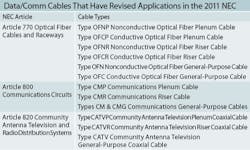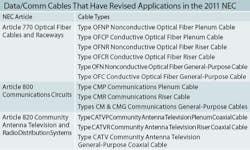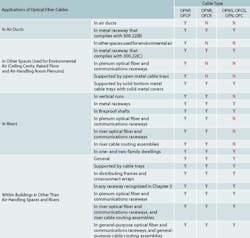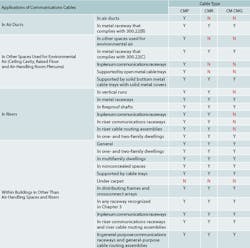Data communications cable applications in the 2011 National Electrical Code
From the December, 2011 Issue of Cabling Installation & Maintenance Magazine
A set of tables in the latest edition of the Code helps reduce or eliminate the need to infer which applications are prohibited.
By Stanley Kaufman, Cablesafe Inc.
The National Electrical Code is published by the National Fire Protection Association (NFPA; www.nfpa.org) with revisions on a three-year schedule. The 2011 NEC, which replaces the 2008 NEC, was released by NFPA in August 2010. There were many changes of interest to manufacturers, installers and users of communications cable and connectivity products.
This is the sixth in a series of nine articles, contributed on behalf of the Communications Cable and Connectivity Association (CCCA; www.cccassoc.org), concerning those relevant changes in the NEC.
The five preceding articles can be seen in the previous five issues of this magazine.
This article discusses the changes in the data/comm cable applications in Articles 770, 800 and 820 of the 2011 NEC.
The text of the applications sections of Article 770, 800 and 820 in the 2008 NEC cover the applications of cables and raceways, and, notwithstanding the fact that the title of the section is “applications,” contain numerous installation rules. In the 2011 NEC, installation rules have been moved out to the installation sections (770.113, 800.113 and 820.113).
In sections 770.154, 800.154 and 820.154 in the 2008 NEC, nearly all of the application statements are positive statements of where cable, for example, is permitted to be used. Rarely do these sections state the prohibited applications, leaving to the user to infer the prohibited applications. For example, 800.154(C)(6) states that undercarpet cable is permitted to be installed under carpet, with no indication of any other permitted uses or prohibited uses.
The applications are now covered in tables [Tables 770.154(a), 800.154(a) and 820.154(a)]. A note at the bottom of each table explains that an “N” in the table indicates that the cable type is not permitted to be installed in the application. A “Y*” indicates that the cable is permitted to be in the application, “subject to the limitations” of the installation section. The NEC uses a “Y*” rather than a “Y” to emphasize that permitted applications are subject to the limitations of installation rules. No asterisk is needed for the prohibited applications indicated by an “N” because the concept of “no” is simple.
The nearby table illustrates the applications of optical fiber cables. This table only covers cable applications; Table 770.154(a) in the 2011 NEC includes applications for cable routing assemblies and optical fiber raceways in addition to optical fiber cables.
For emphasis, the prohibited applications are indicated by a red “N.”
The other table within this article illustrates the applications of general-purpose, riser and plenum communications cables. Table 800.154(a) in the 2011 NEC includes applications for limited-use communications cables, communications wires and communications raceways.
If you agree that expressing cable applications in a table is simpler and provides more information than the text they replaced, then introducing similar tables into Articles 725 and 760 is a logical next step. Also, separating the large application table in Article 800 into two smaller tables—one for wires and cables and the other for raceways—might improve the comprehension of that table.
Author’s disclaimer: This paper, provided by the Communications Cable and Connectivity Association (CCCA), is offered for general information and educational purposes. It is not offered, intended, nor should it be relied upon as legal advice. The paper does not set forth the views of any member or any other party, nor may it be taken as such. CCCA makes no warranty regarding the accuracy of the information provided in this paper, and expressly disclaims any implied warranties and any liability for use of the paper or reliance on views expressed in it. CCCA does not endorse, approve or certify any information set forth in this paper, nor does it guarantee the accuracy, completeness, efficacy, timeliness or correct sequencing of such information. Use of the paper and the views expressed in it is voluntary, and reliance on it should only be undertaken after an independent review of its accuracy, completeness, efficacy and timeliness, and based on the individual facts and circumstances of a user.
Stanley Kaufman, Ph.D. is principal of CableSafe Inc. and a consultant to the CCCA (CCCA; www.cccassoc.org).



